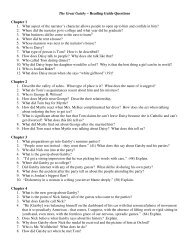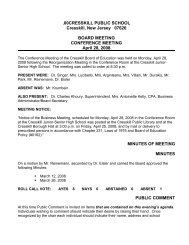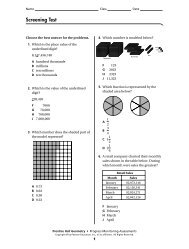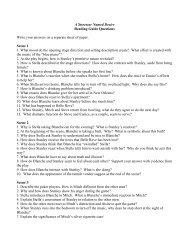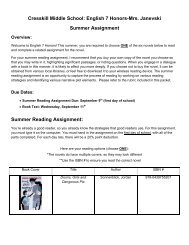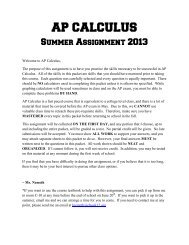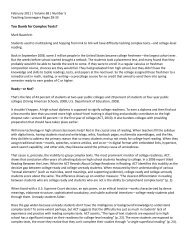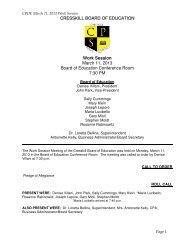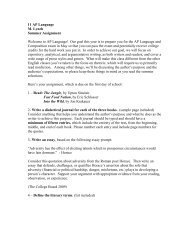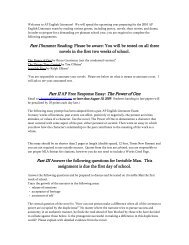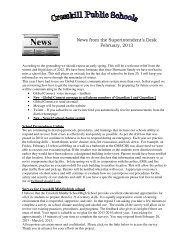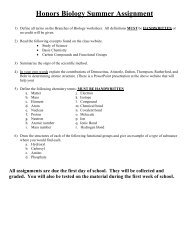AP Art Summer Assignments, 2013-14 (pdf) - Cresskill Public Schools
AP Art Summer Assignments, 2013-14 (pdf) - Cresskill Public Schools
AP Art Summer Assignments, 2013-14 (pdf) - Cresskill Public Schools
Create successful ePaper yourself
Turn your PDF publications into a flip-book with our unique Google optimized e-Paper software.
WELCOME TO <strong>AP</strong> STUDIO ART!<br />
Important information for you:<br />
Mrs. Gelchinsky’s email: info@kitnessart.com or csfeline@gmail.com or cstraub@cboek12.org<br />
Also be familiar with my classroom site, which WILL be regularly updated with assignments<br />
and due dates. You will be responsible for knowing the information on the <strong>AP</strong> Section of the<br />
site.<br />
The College Board Website’s Studio <strong>Art</strong> Page:<br />
http://www.collegeboard.com/student/testing/ap/sub_studioart.htmlstudioart<br />
Here you will find important information about the course and the <strong>AP</strong> Portfolio. You can also<br />
see examples of student portfolios and their scores.<br />
THE <strong>AP</strong> STUDIO EXAM AND THE TWO PORTFOLIO TYPES<br />
The <strong>AP</strong> Studio <strong>Art</strong> “exam” is a portfolio of artwork that you will be creating throughout the<br />
year. Each student has a choice between two “types” of portfolios: 2D Design and Drawing.<br />
Both require the same number of artworks, but the focus of the requirements for these two<br />
portfolios are different. As part of your summer assignments, you will become familiar with<br />
the concepts central to BOTH portfolios, and when you return to school in September, you will<br />
choose one. Below is a short explanation of both portfolios:<br />
2D Design<br />
Design involves purposeful decision-making about using the Elements and Principles of <strong>Art</strong> in<br />
an integrative way. In the 2-D Design Portfolio, you should demonstrate your understanding<br />
of design principles as applied to a two-dimensional surface. The Principles of Design<br />
(Unity/variety, balance, emphasis, contrast, rhythm, repetition, proportion/scale, and<br />
figure/ground relationship) can be articulated through the visual elements (line, shape, color,<br />
value, texture, space). Any 2-D process or medium can be submitted, including, but not<br />
limited to, graphic design, digital imaging, photography, collage, fabric design, weaving,<br />
illustration, painting, printmaking, etc.<br />
Videotapes, three-dimensional works, and photocopies of your work in other media may not be<br />
submitted.<br />
Drawing<br />
In the Drawing Portfolio, your mastery of drawing can be demonstrated through a wide range<br />
of approaches and media. Light and shade, line quality, rendering of form, composition,<br />
surface manipulation, and the illusion of depth are drawing issues that can be addressed<br />
through a variety of means, which could include painting, printmaking, mixed media, etc.<br />
Abstract, observational, and inventive works may be submitted. The range of marks used to<br />
make drawings, the arrangement of the marks, and the materials used to make the marks are<br />
endless. Any work submitted in the Drawing portfolio that incorporates digital or<br />
photographic processes must address drawing issues such as those listed above, as well as<br />
mark-making. Using computer programs merely to manipulate photographs through filters,<br />
adjustments, or special effects is not appropriate for the Drawing portfolio.
<strong>AP</strong> STUDIO ART SUMMER ASSIGNMENTS<br />
Complete and bring to class all assignments on Tuesday, September 10th, <strong>2013</strong><br />
Assignment #1:Materials for <strong>AP</strong> Studio <strong>Art</strong>: 10 points<br />
A thumb drive or external hard drive<br />
Sketchbook (“Cachet” black hardcover sketchbook is recommended)<br />
A variety of drawing pencils<br />
A set of colored pencils<br />
Compressed charcoal or charcoal pencils<br />
A kneaded rubber eraser<br />
A set of 12-24 acrylic paint tubes (Liquitex, Winsor Newton, and Golden are good brands)<br />
**If you plan on doing the 2D design portfolio, it would be very helpful to have your own SLR<br />
camera but they are expensive and not required.<br />
Assignment #2: 100 points<br />
Read chapters 1 and 3 from the book, “Launching the Imagination”, by Mary Stewart<br />
(second edition). PDFs of these chapters can be found on my course website. It is<br />
recommended, but not required, to purchase this book (look on amazon.com).<br />
In your sketchbook, create sections or pages that correspond with each of the boxes in the<br />
table below (each section may be several pages or just one page) For each section, you will<br />
“define” each term by creating or finding a visual example. You may hand draw the visual<br />
definition OR clip an example from an outside source and tape/glue it in. This should be<br />
neatly done so that it is CLEAR what term goes with each image. You are encouraged to get<br />
creative and make your examples interesting, fun, and artful while still staying true to the<br />
meaning of the terms.<br />
Each visual example should be different and unique to the term it represents. Be sure that<br />
your visual examples wont be confused with the wrong term. You may use words/sentences,<br />
arrows, or other indicators for clarification or to show exactly what part of an image best<br />
defines the term.<br />
Chapter 1: Basic Elements<br />
LINE<br />
Find a visual example of the following:<br />
Line<br />
Continuity<br />
Contour lines<br />
Organizational Lines<br />
Implied Line<br />
Closure<br />
Hatching<br />
Crosshatching<br />
SH<strong>AP</strong>E<br />
Find a visual example of the following:<br />
Volume<br />
Gradation (shading)<br />
Positive Shape<br />
Negative Shape<br />
Figure/Ground Reversal<br />
Rectilinear Shapes<br />
Curvilinear Shapes<br />
Organic Shapes<br />
Nonobjective Shape<br />
Pure Forms<br />
Representational Shapes<br />
Abstract Shapes
TEXTURE<br />
Find a visual example of the following:<br />
Physical Texture<br />
Visual Texture<br />
Invented Texture<br />
VALUE<br />
Find a visual example of the following:<br />
Value<br />
Contrast<br />
Value Distribution<br />
Atmospheric Perspective<br />
Chapter 3: Principles of Two-Dimensional Design<br />
UNITY AND VARIETY<br />
BALANCE<br />
Find a visual example of the following: Find a visual example of the following:<br />
Composition<br />
Balance<br />
Unity<br />
Visual Weight<br />
Variety<br />
Symmetrical Balance<br />
Repetition<br />
Approximate Symmetry<br />
Proximity<br />
Radial Symmetry<br />
Continuity<br />
Asymmetrical Balance<br />
Focal Point<br />
Imbalance<br />
Closure<br />
Pattern<br />
SCALE AND PROPORTION<br />
Find a visual example of the following:<br />
Proportion<br />
Scale<br />
EMPHASIS<br />
Find a visual example of the following:<br />
Emphasis<br />
Anomaly<br />
Centricity<br />
Eccentricity<br />
MOVEMENT<br />
Find a visual example of the following:<br />
The Kinesthetic Response<br />
Before and After<br />
Multiplication<br />
RHYTHM<br />
Find a visual example of the following:<br />
Rhythm<br />
CREATING THE ILLUSION OF SPACE<br />
Find a visual example of the following:<br />
Linear perspective<br />
Picture plane<br />
Vanishing Point<br />
Horizon line<br />
One-Point perspective<br />
Two-point perspective<br />
Three-Point perspective<br />
Amplified perspective<br />
Fractured Space<br />
Layered Space<br />
Show the illusion of space using:<br />
overlap<br />
size variation<br />
definition (atmospheric perspective)<br />
location
Assignment #3: Photograph your <strong>Art</strong>work, 50 points.<br />
Photograph FOUR or MORE finished artworks that you have created and EMAIL THESE<br />
PHOTOS TO: info@kitnessart.com or csfeline@gmail.com<br />
You CAN use artworks from previous years and outside classes for the Breadth part of the <strong>AP</strong><br />
Portfolio. These photographs should be HIGH quality (taken with a good SLR camera)<br />
Assignment #3 part 2: Image Collection/Concentration ideas<br />
50 points.<br />
COLLECT AT LEAST 10 images that might help inspire your Concentration idea.<br />
Tape these into your sketchbook in a page after the notes you took from the reading.<br />
These images can be taken from any source, including magazines, newspapers, or cards you get in<br />
galleries, as long as you can tape it into your sketchbook. It does not have to be an image of a formal<br />
work of art by a professional artist, but if it is, you should record the name of the artist.<br />
THEN, Make a list of FIVE different ideas for the Concentration. You only need about a<br />
sentence or word for each idea. The Concentration is a theme or idea about which you will<br />
create12 different artworks. Think of the Concentration as a visual expression about<br />
something that you find interesting. It can be as deep and complex as “World Peace” or as<br />
simple as “cupcakes,” but you had better be interested in the topic enough to make 12 pieces<br />
about it!<br />
**<strong>Assignments</strong> #3 and #3 part 2 will be worth 100 points together**<br />
Assignment #4: Original <strong>Art</strong>work, 100 Points<br />
Look over the images you collected for assignment 2. Consider what you really like about<br />
these images, whether it be the subject matter, the use of color, the style of a work of art, etc.<br />
Try to figure out what your choices reveal about what types of images attract or interest you.<br />
Then, use one or more of these 10 images as inspiration for a totally original artwork.<br />
You do not HAVE to base it on one of your proposed Concentration ideas from assignment 2, but doing<br />
so will probably be helpful for you.<br />
This artwork should be HIGH QUALITY and at least 9”x 12”—not a sketch in a sketchbook. The<br />
material is up to you. If you create a drawing, it should be well cared-for, not folded, rolled up or<br />
crushed.<br />
Sorry, but you cannot create a sculpture, as we will not be able to use it for the <strong>AP</strong> portfolio. You can<br />
create works with low relief and texture, but they should not be more than 3 inches thick.<br />
Assignment #5: Still-life, 100 Points<br />
Create a still life on your own or take a drawing class where you can draw a still life. You can<br />
draw any objects you wish (school appropriate). Draw these objects in pencil or charcoal with<br />
a full range of value. Present these objects in an interesting and unique way, and fill your<br />
page. Your still life paper should be at least 9”x12” in size.<br />
**Due Friday September 13 th : To receive a grade for projects #4 and #5, you will take a<br />
digital photo of your artwork (you can do this when we return to school) and send this digital file to<br />
Mrs. Gelchinsky via email. The date of the email will act as your hand-in date. You should still bring<br />
these assignments with you to class on September 10 th .
Assignment #6: Visual Diary, 100 points<br />
For this project, you will be required to create a “visual diary.” Facebook statuses are posted<br />
every day to express a person’s thoughts, and can be considered a diary of sorts.<br />
Create at least 7 entries—doing one each day for a week, doing one every other day for two<br />
weeks, one a week for 7 weeks—whatever feels best to you. For each entry, you are to<br />
visually record your day as a whole, or the most important aspect of the day, or the most<br />
memorable part, or anything you feel is pertinent. Your solutions can be literal or abstract,<br />
tightly rendered or spontaneously designed, and you should allow your concepts to dictate the<br />
appropriate medium (the medium is your choice). Also, underneath each solution, include an<br />
explanation of the intent of your design. You can use the format below to create your designs.<br />
These should be done in your sketchbook by tracing the format below onto a sketchbook page,<br />
no exceptions.<br />
Area for Design<br />
Area for Explanation<br />
See the next page for examples!
One (important) last word…you MUST read this.<br />
The paragraphs below have been taken directly from the <strong>AP</strong> Studio<br />
<strong>Art</strong> site. You will be expected to understand what is stated below:<br />
Ethics, <strong>Art</strong>istic Integrity, and Plagiarism<br />
Although the use of appropriated images is common in the professional art world today,<br />
students who make use of borrowed images should demonstrate a creativity and<br />
sophistication of approach that transcends mere copying. This policy is clearly stated in the<br />
sections on each portfolio in this booklet: “Any work that makes use of (appropriates) other<br />
artists’ works (including photographs) and/or published images must show substantial and<br />
significant development beyond duplication. This is demonstrated through manipulation of<br />
the formal qualities, design, and/or concept of the source. The student’s individual “voice”<br />
should be clearly evident. It is unethical, constitutes plagiarism, and often violates copyright<br />
law simply to copy an image (even in another medium) that was made by someone else and<br />
represent it as one’s own.” Teachers and students are strongly encouraged to become<br />
knowledgeable about copyright laws. In evaluating portfolios, the Readers look for original<br />
thinking. Students are encouraged to create artworks from their own knowledge, experiences,<br />
and interests. Universities, colleges, and professional schools of art have rigorous policies<br />
regarding plagiarism. <strong>AP</strong> Studio <strong>Art</strong> endorses these policies. Digital images of student work<br />
that are submitted in the portfolios may be edited;<br />
however, the goals of image editing should be to present the clearest, most accurate<br />
representation of the student’s artwork, and to ensure that images meet the requirements of<br />
the Digital Submission Web application.<br />
When submitting their portfolios, students must indicate their acceptance of the following<br />
statement: “I hereby affirm that all works in this portfolio were done by me and that these<br />
images accurately represent my actual work.”



